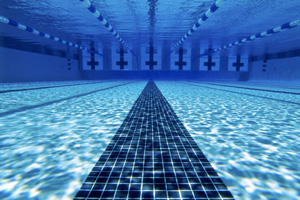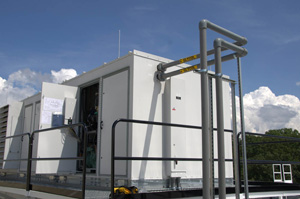Arguing that new dehumidifier technologies reduce operating expenses for natatoriums, Ralph Kittler, PE, walks us through the latest advancements.
Arguing that new dehumidifier technologies reduce operating expenses for natatoriums, Ralph Kittler, PE, walks us through the latest advancements.
 The thousands of hotels with indoor swimming pools built throughout the last 25-year hospitality boom period of the Middle East-North Africa (MENA) region have a unique opportunity to significantly cut energy costs. This is because the useful lifecycles of these hotels’ older technology indoor pool dehumidifiers are ending, and today’s advanced technology replacements offer significant energy improvement options over what was available 25, 20 and even 10 years ago. If the built-up approach to control the humidity was used, then the potential for savings is even greater now, as those systems consume more energy.
The thousands of hotels with indoor swimming pools built throughout the last 25-year hospitality boom period of the Middle East-North Africa (MENA) region have a unique opportunity to significantly cut energy costs. This is because the useful lifecycles of these hotels’ older technology indoor pool dehumidifiers are ending, and today’s advanced technology replacements offer significant energy improvement options over what was available 25, 20 and even 10 years ago. If the built-up approach to control the humidity was used, then the potential for savings is even greater now, as those systems consume more energy.
The tried and proven technology of conventional dehumidifiers is typically the approach used by indoor pool designers. These self-contained HVAC systems not only control humidity, but also heat or cool the space and use heat recovery to provide free pool water heating.
A step up to new packaged natatorium dehumidifiers with high technology options will significantly cut energy costs and refrigerant liabilities without costing much more, if at all, than conventional equipment. And even if higher technology does cost more, the payback is generally short and the potential for energy savings will most probably amount to hundreds of thousands of dollars over the higher technology unit’s lifecycle.
Beyond retrofits of existing pools, the hundreds of MENA region hotels slated for or currently amidst construction should seriously consider today’s indoor pool dehumidifier technology advancements.
Keeping the new dehumidifier efficiently tuned
Dehumidifiers are every bit as intricate as the most sophisticated HVAC system, computer or car, and, therefore, need periodic calibration and tuning to maintain their designed energy efficiency. There are literally dozens of parameters a dehumidifier monitors and controls to keep energy efficiency at the highest level.
Furthermore, most hotel maintenance staff and engineers typically aren’t trained to detect these inconsistencies. Even a hotel’s preferred HVAC service contractor might be lacking in the fundamentals of dehumidifier service, which requires decidedly different and more complex troubleshooting than conventional air conditioning training.
Imagine, for example, if an operator was not aware that its unit was not adjusted for optimum moisture removal effectiveness. This inefficiency could cost the operator thousands of dollars in energy costs in a large facility. The dehumidifier’s ineffectiveness may not immediately affect the facility’s indoor air comfort, and could possibly continue unnoticed until possibly detected at an annual service check.
One technology advancement is web-based monitoring capabilities for the purpose of spotting early inefficiency developments before they result in component breakdown or months of energy-wasting operation.
Manufacturers have realised the benefits of frequent monitoring and have taken advantage of recent microprocessor advancements and the Internet’s potential to access real-time information flow and historical trend records of a dehumidifier’s operating parameters. On-board monitor/control microprocessors can now send the dehumidifier’s vital operating statistics daily, regardless of where in the world it is located, to factory technicians via an on-board Ethernet connection. These manufacturers offer a free daily monitoring service and even have smartphone applications, where an authorised user can access a dehumidifier unit from anywhere on the globe. The manufacturer can alert the facility manager about any issues and oversee the local service contractor set-up and adjust the unit to ensure optimum performance. Alarms can also be sent to the factory to ensure a quick resolution of any problem. A building owner not taking advantage of these minimal-cost options would be penny-wise and pound foolish.
The latest energy-saving components
Direct drive plenum fans with variable frequency drives (VFDs) are also advanced technology examples for potential energy savings of up to 20% versus conventional dehumidifier unit belt-driven fans.
When VFDs are added to direct drive technology, there is potential for even more efficiency with the ability of ramping up or down the fan speed. Adjusting the fan speed via a VFD also adds more flexibility for air balancing. Another potential advantage VFDs offer is the ability to ramp down the plenum fan speed during off-peak hours when less overall supply airflow might be a consideration.
While these technologies have been available for years, it has only recently been introduced into the dehumidifier market, and not all manufacturers offer them. Until recently, the preferred method was fan belts connecting the fan motor to the blower – a method that needs regular adjustments and fan belt replacements. Conversely, the direct drive method connects the motor directly to the fan shaft, thus eliminating friction, noise, maintenance and power transfer inefficiencies associated with belt drives.
A direct drive plenum fan and a VFD combination offers approximately 20% reduction in fan motor energy and, therefore cost savings – a staggering figure, considering the fact that a typical pool dehumidifier’s fans operate 24/7. The payback is instantaneous, since direct drive plenum fans/VFD options are comparable in price to belt-driven systems.
Energy recovery – using exhaust air to pre-heat outdoor air
Building designers generally adhere to ASHRAE Standard 62 for indoor air quality (IAQ), which stipulates the minimum fresh air requirements for various applications, activities and type of facilities.
Of course, outdoor air induction requires compensatory exhaust air, which must surpass the outdoor air volume in order to maintain the negative pressure natatoriums require. The option of exhaust air energy recovery now offered on many dehumidifier brands can save significant amounts of energy. Whether it is using extremely energy-rich 26°C (80°F) space exhaust air to pre-cool the 37°C (100°F) outdoor air of Dubai in August, or using it to pre-heat the sub-10°C (50°F) air of Cairo in January, exhaust energy recovery can potentially save tens of thousands of dollars annually.
Remotely located exhaust fans can also be outfitted with heat transfer coils that are piped to the dehumidifier. The exhaust air is an energy source that designers and operators should always consider for heat recovery.
 In the same sense, remotely located chemical- source-capture exhaust fans are now available on commercial pool gutters. The gutter itself actually draws chloramines – gaseous contaminants that cause Lifeguard Lung and other common respiratory ailments – away from the pool surface where swimmers breathe. The chloramines, which are chlorine molecules attached to contaminants such as ammonia or perspiration, are drawn off the pool surface and exhausted to the dehumidifier for pre-conditioning outdoor air.
In the same sense, remotely located chemical- source-capture exhaust fans are now available on commercial pool gutters. The gutter itself actually draws chloramines – gaseous contaminants that cause Lifeguard Lung and other common respiratory ailments – away from the pool surface where swimmers breathe. The chloramines, which are chlorine molecules attached to contaminants such as ammonia or perspiration, are drawn off the pool surface and exhausted to the dehumidifier for pre-conditioning outdoor air.
The combination of evacuating pool surface chemical gases through a gutter system can also make a tremendous difference in IAQ throughout a hotel or community pool facility and many times eliminate “chlorine” odour complaints altogether.
The future is in refrigerant reduction
The expense and environmental damage liabilities of hyydrochlorofluorocarbons (HCFC) refrigerants, such as R-22 and hydrofluorocarbons (HFC), such as R-134a and R-410A, should have a bearing on future retrofit and new construction indoor pool dehumidifier choices.
Advanced technology from HVACR manufacturers is offering dramatically reduced refrigerant charges using technology where polypropylene glycol serves as an alternative heat rejection liquid instead of HCFC or HFC refrigerants. Glycol is up to 95% less expensive than refrigerants and installing its PVC versus copper piping reduces job costs. If a leak occurs, liquid glycol is not environmentally damaging to the atmosphere versus the gaseous state of refrigerants. Choosing equipment that uses up to 85% less refrigerants than conventional dehumidifiers is a wave of the future, especially for green projects.
There are some significant side benefits to these systems:
Incorporating some or all of these energy-reduction innovations in new construction or retrofit projects promises unprecedented IAQ, reduced energy, short paybacks and potentially hundreds of thousands of dollars in long-term savings over the equipment’s lifecycle.
The benefits also outweigh the economics of continuing to use an existing older, lower technology dehumidifier until it reaches its full lifecycle. These recent advancements might prompt indoor pool owners to seriously analyse the efficiency of their current equipment, environmental impact and overall operational costs. A new system might have an attractive payback and deliver better overall performance.
The writer is a Co-Founder and Vice President of Sales/Marketing at Seresco Technologies Inc, an Ottawa, Ontario-based manufacturer of DX and chilled water coil natatorium dehumidifiers. He can be contacted at: ralphkittler@serescodehumidifiers.com
Copyright © 2006-2025 - CPI Industry. All rights reserved.